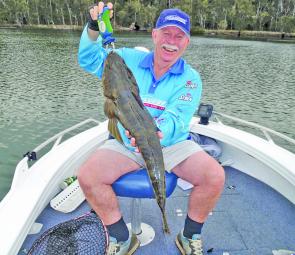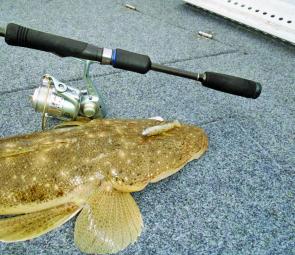Flathead are special because of a number of things: They can be caught in very shallow water, they blend in very well with their surroundings, they are reasonably easy to catch year round, they fight well on light gear and they can grow quite large.
Dusky flathead, or any other flathead species, rely on their ability to camouflage themselves so that they can ambush and capture their prey.
They live partially buried in the sand or mud, often along an edge of a weed line or rock wall, facing the current. When an unsuspecting small fish, prawn or crab passes by, the flattie uses its lightning turn of speed to grab its prey.
Places worth a look for flathead in the estuaries are along the edges of mangroves, breakwalls, retaining walls, drop-offs, the edges of rock bars, gravel patches, mussel and cockle beds, sand and mud flats, the edges of deep holes, edges of fast currents, under oyster racks, at the foot of marker buoys and poles, the bases of bridge pylons and under pontoons.
Offshore anglers encounter sand, blue-tailed and tiger flathead in areas that have sand, mud, crushed shell and gravel patches. You could also try working the edges of close reefs and bomboras.
Flathead will take most baits but my favourites are strips of bonito, frigate mackerel, yellowtail, cowanyoung, striped tuna, slimy mackerel, pike and tailor.
These strips can be rigged on ganged hooks but are also very effective on a fixed or sliding snood rig. You can also use the fixed or sliding snood rig when using whole live fish.
If you are using white or blue bait on gangs, you usually find that the blue bait is longer than the whitebait.
Depending on the size of the bait you have to increase the number of hooks to add extra length. I usually use two 1/0s or 2/0s in whitebait and three 1/0s or 2/0s in blue pilchards.
When using gangs all of the hook points must protrude from the body of the bait, the last hook point must be down near the back of the bait the whole rig must be straight so that it doesn’t twist unnaturally.
Whether I am fishing from the shore in an estuary or off the beach into a nice gutter, I make sure that my bait is always slowly moving. I cast my bait, allow it to hit the bottom, point the rod tip towards the bait and wind up the slack.
I then twitch the rod tip backwards, pause three or four seconds, then repeat until the bait is back at my feet or I’ve hooked a fish.
When chasing flathead on softies I look for a jig head with a chemically sharpened hook with a point that can withstand getting snagged a number of times and wire that won’t straighten out.
The keeper collar or barb must hold the plastic on the jig without damaging it and the head must suit the type of soft plastic I’m using.
Soft plastics come in so many shapes, sizes and colours and so do the jig heads. Try to match the shape of the head with the shape and size of the plastic, and the weight of the head with the depth of water and tidal run so it will stay close to the bottom.
If you are walking or wading a shallow shore for flathead, make sure you walk slowly and quietly. Many times I have seen an angler scare off a flathead that has been almost at their feet.
Cast the water along the shore ahead of you thoroughly because it is very disappointing to spook a big flathead without it having seen your lure.
Cast into the dark, inviting depths by all means, but do not neglect the shallow bank ahead and to the side. Even the biggest flathead may remain buried in the sand and invisible until your lure entices it to strike – or you walk right up and frighten it off.
Cast to inviting formations and structure by all means, but also cover the featureless sand bar stretching out ahead of you. Your first strike often comes from what appears to be featureless water.
Reads: 2343
The author with an 80cm flathead caught while chasing bream in St Georges Basin.

Not all duskies are dark, depending on where you catch them. Over muddy or weedy bottom flatties tend to be darker and over clear sand they tend to be much lighter. This one took a 3” Gulp Shrimp.

Tasty flounder are welcome by-catch when targeting flathead.




